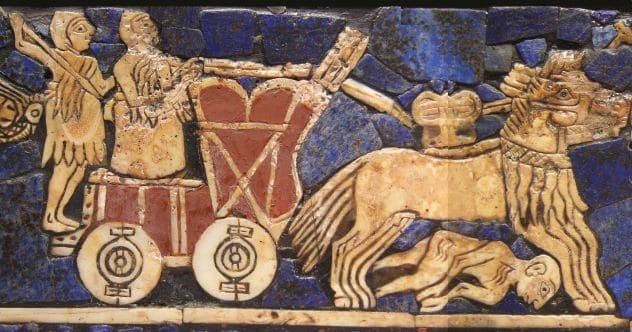Introduction
Ever wondered about the civilizations that laid the groundwork for our modern world? Among the most mysterious and influential is ancient Sumer. Popping up seemingly out of nowhere during the Stone Age, the Sumerians brought forth incredible advancements. They gave us the first written language, divided time into minutes and seconds, built bustling cities, invented the wheel, and even brewed beer! By the fourth millennium BC, they had already established over ten thriving city-states.
Their customs, beliefs, and religious practices didn’t just fade into history; they became a blueprint for cultures that followed, and surprisingly, many echo in our lives today. Get ready to dive into some of the most astonishing and downright strange facts about the ancient Sumerians that will change how you see history.
10. They Believed in Vampires
Think vampire tales are a relatively modern thrill? Think again! The ancient Sumerians had their own blood-curdling stories. They believed in two types of demons with a taste for blood or human life force: the Ekimmu and the Utukku.
The Ekimmu were said to be the restless, enraged spirits of those who died unburied. They roamed the earth, seeking refuge only beneath the ground, a classic trait we associate with vampires today. The Utukku, on the other hand, were spirits of the dead who were buried without proper offerings or had been forgotten by their loved ones. As a result, these spirits would return from the afterlife to torment anyone they encountered, constantly seeking nourishment from their victims. Like the vampires of Eastern European folklore, the Utukku was a relentless predator, incredibly difficult to destroy. Interestingly, one Sumerian legend speaks of an Utukku named Ea-Bani who, despite their typically malevolent nature, befriended the hero Gilgamesh and became his ally.
9. Legends of Werewolves Were Real to Them
The idea of humans transforming into wolves wasn’t just a medieval fantasy; it has roots in one of the world’s oldest written stories. Dating back to 2100 BC, the Epic of Gilgamesh, found inscribed on 12 clay tablets, tells of the great king Gilgamesh being pursued by the goddess Ishtar. He rejects her, reminding her of the grim fate of her previous lovers, whom she had transformed into wolves.
Many experts agree that a belief in werewolves was an accepted part of the ancient Sumerian worldview. This belief might have even played a role in the story surrounding King Nebuchadnezzar II (ruler from c. 605 to 562 BC). Known for demolishing Jerusalem’s First Temple and building the Hanging Gardens of Babylon, Nebuchadnezzar, according to the Book of Daniel, suffered a severe mental illness. For seven years, he believed he had turned into a wolf, a condition known today as lycanthropy.
8. Sumerians Were “Flat-Earthers”
Long before debates about the Earth’s shape filled internet forums, the Sumerians had their own cosmic model. They envisioned the heavens as a series of three domes covering a flat Earth. Each dome was crafted from a different precious stone.
The lowest dome, made of jasper, was the home of the stars. The middle dome, constructed from saggilmut stone, housed the Igigi, or the “gods of the heavens.” The highest and grandest dome, made of luludānītu stone, was the personification of An, the god of the sky. Celestial bodies were also linked to specific deities: Venus was Inanna (goddess of love, war, and sex), the sun was her brother Utu (god of justice), and the moon was their father Nanna. For Sumerians, heaven was exclusively for the gods; human souls, upon death, would journey to Kur (later known as Irkalla), a shadowy underworld deep beneath the earth’s surface.
7. Their Creation Story Echoes the Bible
Creation myths are found in nearly every culture, and the Sumerian version offers fascinating parallels to later texts, including the Bible. Many scholars suggest the biblical creation story might be a condensed version of narratives found on Sumerian cuneiform tablets. The Sumerians believed the gods existed even before the known world was formed. While much of their literature from the third millennium BC is lost, remaining fragments speak of a time before the gods, when only An (Heaven) and Ki (Earth) existed.
In this primordial state, everything was dark; there was no sun or moon. The earth was green and water-rich but devoid of life and vegetation. The characters and themes on these tablets bear a striking resemblance to Egyptian hieroglyphics and their doctrines on life’s beginnings. To date, over half a million cuneiform tablets have been unearthed, but only a fraction, around 60,000, have been translated and shared with the public, hinting at more secrets yet to be uncovered.
6. They Built the First Pyramids (Ziggurats)
When you think of ancient pyramids, Egypt usually comes to mind. However, the Sumerians were constructing their own impressive step pyramids, known as ziggurats, which were central to their religious and social lives. These structures first appeared around 2200 BC. Ziggurats were typically square or rectangular, featuring sloping sides, terraced levels, and often garden walkways – the famous Hanging Gardens of Babylon was one such structure. They lacked internal chambers and could reach heights of around 52 meters (170 feet).
Although perhaps not as globally renowned as Egypt’s pyramids, ziggurats were among the world’s very first step-pyramids. In fact, the first ziggurat was built more than 400 years before Egypt’s first step pyramid. Tepe Sialk, located in central Iran, is considered the oldest known ziggurat. Many scholars believe this indicates a connection, suggesting that the revolutionary engineering and unique belief systems that led to these structures were refined and spread over time.
5. They Were Bloodthirsty Warriors
The land of Sumer was not always peaceful. Its city-states frequently engaged in brutal wars over territory, water, and other natural resources. Alliances shifted constantly, with each state maintaining its own ruler until Eannatum of Lagash rose to power and successfully united all of Sumer under his command. This first Sumerian empire lasted until the arrival of Sargon the Great of Akkad around 2234 BC.
Sargon was a military innovator, employing both chariots and well-equipped infantry. His foot soldiers wielded deadly combinations of swords, spears, clubs, maces, and slings. His chariot troops used bows, arrows, and spears. The constant warfare spurred rapid advancements in military technology. The invention of the chariot was a particularly significant development. Sumerian chariots typically had four wheels and were drawn by at least four onagers (wild asses), which were controlled by rings through their nostrils and reins secured to the chariot, allowing for precise maneuvering in battle.
4. Their First Female Ruler Became a Deity
Around 2500 BC, Kubaba (also known as Kug-Baba or Kubau) became the only queen to ever rule the Sumerians on her own. Her reign, said to have lasted a century, was marked by peace, growth, and harmony. Her name is recorded on the Sumerian King List, a document that chronicles Sumerian rulers and their achievements. After her son, Puzur-Suen, succeeded her, Kubaba’s rule was said to have been so significant and divinely approved by the Annunaki gods that she was later deified.
She became a revered figure in Anatolian and Hurrian cultures. An interesting twist to her story suggests that before becoming queen, Kubaba might have been a tavern keeper. In ancient Sumer, this was a surprisingly respectable position, and one rarely held by women. Today, only a single statue of this remarkable ruler survives.
3. Was Moses a Famous Sumerian Figure?
The story of Sargon the Great, the Akkadian king who conquered and ruled Sumer around 2334 BC, shares striking similarities with the biblical tale of Moses. Sargon’s origins are shrouded in mystery. One legend claims he was the secret child of a high priestess who, to protect him, placed him in a reed basket and set him adrift on a river. This narrative closely mirrors the early life of Moses in the Old Testament.
Sumerian legends also describe him as the son of a gardener who rose to become the cupbearer to the king. Cuneiform tablets, particularly an inscription known as “The Legend of Sargon,” offer more insight. It states he was the illegitimate son of a “changeling”—a term that could refer to a high-priestess or even the goddess Inanna. His mother concealed her pregnancy and, unable to raise him openly, placed him in a tar-sealed basket on the Euphrates River. He was later discovered by a man named Akki, a gardener for Ur-Zababa, King of Kish.
2. And What About Noah?
The story of a catastrophic Great Flood is found in cultures and religions worldwide. While many know the biblical account of Noah and his Ark, the tale has much older roots in ancient Mesopotamia. The Epic of Gilgamesh, dating back nearly five thousand years, contains a remarkably similar story. In it, a man named Utnapishtim is warned by the gods of an impending flood designed to wipe out humanity.
He quickly builds a massive boat, reinforcing it with pitch and tar, and loads it with his family, animals, and various seeds just before the deluge. After many days of storms, Utnapishtim, much like Noah, releases a bird to search for dry land. The translation of ancient cuneiform tablets in the 19th century confirmed that the Mesopotamian flood legend predates the biblical version. The similarities are so strong that it’s widely accepted the story originated in Mesopotamia, with their version providing details not found in the Hebrew account.
1. Was Gilgamesh’s Father a Demon?
The legendary Gilgamesh, hero of the epic poem that bears his name, was based on a real king who is believed to have ruled the city of Uruk around 2500 BC. His name even appears on the Sumerian King List. Over centuries, numerous myths and legends grew around his exploits, eventually forming the Epic of Gilgamesh.
But there might be an even stranger layer to his story. According to a manuscript dating from 2400 BC, Gilgamesh’s father was not human but a Lillu-demon. This Lillu was one of four types of demons that fell into a vampire-like category. The others included Lilitu (a female vampire demon, who later evolved into the figure of Lilith in Hebrew tradition), Ardat Lilli (a female demon who preyed on men at night), and Irdu Lilli (a male demon who preyed on women at night). Lilitu was depicted as a sexually deviant yet alluring vampire, reminiscent of some modern literary vampires. These varied legends were later adopted by the Babylonians and Hebrews, and similar tales eventually spread across the globe.
Conclusion
The ancient Sumerians were far more complex and, frankly, stranger than many of us realize. From their beliefs in vampires and werewolves to their unique cosmology and foundational myths that echo in later religious texts, their civilization continues to fascinate and surprise. Their advanced knowledge and societal structures laid a path for future cultures, leaving an indelible mark on human history. These ten facts offer just a glimpse into the enigmatic world of Sumer, reminding us that the past is often more astonishing than fiction.
What fact about the Sumerians shocked you the most? Loved learning about these ancient mysteries? Leave your comment below and share your thoughts!










